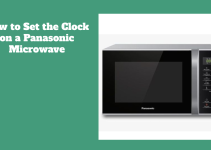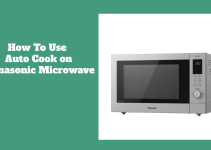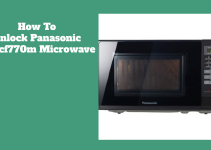I have had a Panasonic microwave for a while now, and there are ways to use the device better to suite every meal that comes your mind.
One of the crucial pieces of knowledge you should have about your Panasonic microwave is using the power level, if you use it right, there is no kind of meat you cannot prepare with it.
One thing you will get from this guide is to understand how to use your Panasonic microwave oven power level function as a professional; this is very important and can equally solve most of the problems you face while using your Panasonic microwave.
What i will be doing today in this guide is to show you how to program the power level manually and cook time on your Panasonic microwave oven and explain why and when you should use different power levels for other foods.
My aim is that by the time you have gone through this post, you can cook various dishes with your microwave oven, using the optimal power level for each one.
What Is The Power Level Function On A Microwave Oven?
The power level function on a microwave oven allows you to adjust the microwave’s intensity to cook your food. Microwaves are electromagnetic waves that heat the water molecules in your food, causing them to vibrate and generate heat. The higher the power level, the more microwaves are emitted and the faster your food will cook.
However, not all foods must be cooked at the same power level. Some foods, such as grains, eggs, and delicate vegetables, require a gentler heat to avoid overcooking, burning, or exploding. Other foods, such as meats, soups, and sauces, need a higher heat to cook thoroughly and evenly. Using the power level function, you can control the amount of microwaves used to cook your food and achieve the best results for each dish.
How To Manually Program The Power Level And Cook Time On A Panasonic Microwave Oven
Depending on the model of your Panasonic microwave oven, the power level function may have different names and options. Refer to your model’s operating manual for specific instructions, or check out this video for a quick demonstration. Here are the general steps to program the power level and cook time on a Panasonic microwave oven:
Step 1: Press the [Micro Power] or [Power Level] button on the control panel. The display window will show the default power level, usually P10 (High) or 1000 W.
Step 2: Press the [Micro Power] or [Power Level] button repeatedly until you reach the desired power level. The display window will show the power level and the corresponding percentage or wattage. For example, P5 is 50% or 500 W, and P1 is 10% or 100 W. You can also press and hold the [Micro Power] or [Power Level] button for 2 seconds to see the power level and percentage or wattage on the display window.
Step 3: Enter the cooking time using the number buttons. The display window will show the cooking time in minutes and seconds.
Step 4: Press the [Start] button to start cooking. The display window will show the remaining cook time and the power level.
How To Choose The Right Power Level For Different Foods
The power level that you should use for different foods depends on several factors, such as the type, size, shape, quantity, and temperature of the food, as well as your preference and taste. Generally, it would be best to use a higher power level for foods that need to be cooked quickly and evenly and a lower power level for foods that need to be cooked slowly and gently. Here are some examples of foods and the recommended power levels for them:
1. Liquids: Use P10 (High) or 1000 W for liquids, such as water, milk, coffee, tea, and soup. This will heat them fast and evenly. Be careful not to overheat liquids, as they may boil or splatter.
2. Meats: Use P10 (High) or 1000 W for meats, such as chicken, beef, pork, and fish. This will cook them thoroughly and evenly. You may need to turn or stir up the meat just halfway through while it’s cooking to ensure it is cooking evenly. You can also use a lower power level, such as P7 (Med-High) or 800 W, to cook the meat more slowly and retain moisture and flavour.
3. Grains: Use P3 (Med-Low) or 300 W for grains, such as rice, quinoa, oats, and pasta. This will steam them gently and avoid boiling over or burning them. You may need to add more water or broth than usual, as the microwave will evaporate some of the liquid. You can also use a higher power level, such as P6 (medium) or 600 W if you want to cook the grains faster, but you will need to watch them closely and stir them frequently.
4. Eggs: Use P3 (Med-Low) or 300 W for eggs, such as scrambled, poached, or boiled. This will cook them gently and avoid exploding or becoming rubbery. You may need to adjust the cooking time depending on the size and number of eggs and how you like them. You can also use a higher power level, such as P6 (medium) or 600 W if you want to cook the eggs faster, but you will need to watch them closely and pierce them with a fork or knife before cooking to release the steam.
5. Vegetables: Use P7 (Med-High) or 800 W for vegetables, such as broccoli, carrots, potatoes, and corn. This will cook them quickly and evenly while retaining their color, texture, and nutrients. You may need to add water or broth to the dish and cover it with a lid or plastic wrap to create steam. You can also use a lower power level, such as P5 (50%) or 500 W, to cook the vegetables more slowly and softly.
Conclusion
Using the power level function on your Panasonic microwave oven can help you cook various dishes with ease and efficiency more than you can even think of.
When you adjust the power level according to the kind of food and the quantity you have, you will surely get the optimal cooking results for each dish. You can also experiment with different power levels and cooking times to find your preferences and tastes.



